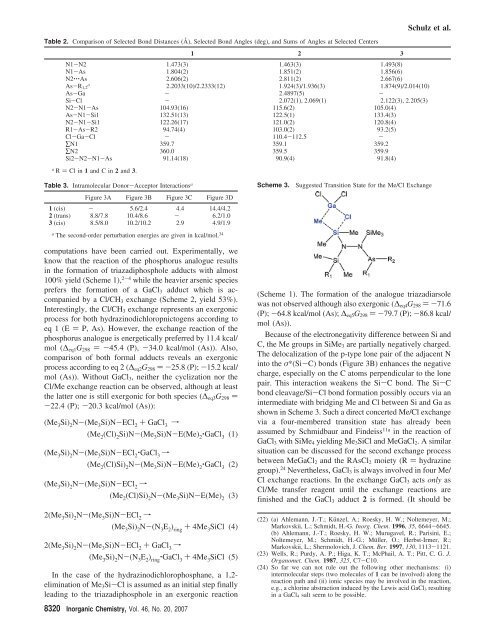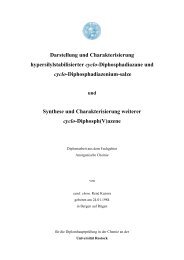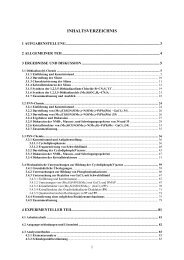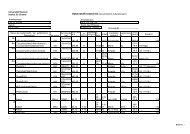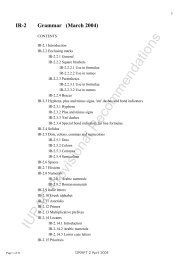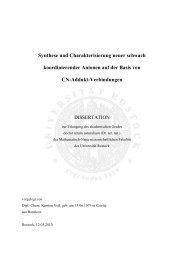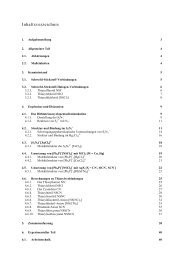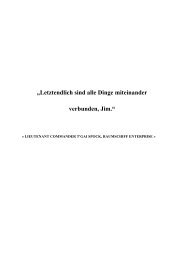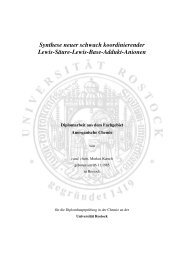Darstellung und Charakterisierung neuer niedrigkoordinierter ...
Darstellung und Charakterisierung neuer niedrigkoordinierter ...
Darstellung und Charakterisierung neuer niedrigkoordinierter ...
Create successful ePaper yourself
Turn your PDF publications into a flip-book with our unique Google optimized e-Paper software.
Table 2. Comparison of Selected Bond Distances (Å), Selected Bond Angles (deg), and Sums of Angles at Selected Centers<br />
computations have been carried out. Experimentally, we<br />
know that the reaction of the phosphorus analogue results<br />
in the formation of triazadiphosphole adducts with almost<br />
100% yield (Scheme 1), 2-4 while the heavier arsenic species<br />
prefers the formation of a GaCl3 adduct which is accompanied<br />
by a Cl/CH3 exchange (Scheme 2, yield 53%).<br />
Interestingly, the Cl/CH3 exchange represents an exergonic<br />
process for both hydrazinodichloropnictogens according to<br />
eq1(E) P, As). However, the exchange reaction of the<br />
phosphorus analogue is energetically preferred by 11.4 kcal/<br />
mol (∆eq1G298 )-45.4 (P), -34.0 kcal/mol (As)). Also,<br />
comparison of both formal adducts reveals an exergonic<br />
process according to eq 2 (∆eq2G298)-25.8 (P);-15.2 kcal/<br />
mol (As)). Without GaCl3, neither the cyclization nor the<br />
Cl/Me exchange reaction can be observed, although at least<br />
the latter one is still exergonic for both species (∆eq3G298 )<br />
-22.4 (P); -20.3 kcal/mol (As)):<br />
In the case of the hydrazinodichlorophosphane, a 1,2elimination<br />
of Me3Si-Cl is assumed as an initial step finally<br />
leading to the triazadiphosphole in an exergonic reaction<br />
1 2 3<br />
N1-N2 1.473(3) 1.463(3) 1.493(8)<br />
N1-As 1.804(2) 1.851(2) 1.856(6)<br />
N2‚‚‚As 2.606(2) 2.811(2) 2.667(6)<br />
As-R1,2 a 2.2033(10)/2.2333(12) 1.924(3)/1.936(3) 1.874(9)/2.014(10)<br />
As-Ga - 2.4897(5) -<br />
Si-Cl - 2.072(1), 2.069(1) 2.122(3), 2.205(3)<br />
N2-N1-As 104.93(16) 115.6(2) 105.0(4)<br />
As-N1-Si1 132.51(13) 122.5(1) 133.4(3)<br />
N2-N1-Si1 122.26(17) 121.0(2) 120.8(4)<br />
R1-As-R2 94.74(4) 103.0(2) 93.2(5)<br />
Cl-Ga-Cl - 110.4-112.5 -<br />
∑N1 359.7 359.1 359.2<br />
∑N2 360.0 359.5 359.9<br />
Si2-N2-N1-As 91.14(18) 90.9(4) 91.8(4)<br />
a R ) Cl in 1 andCin2 and 3.<br />
Table 3. Intramolecular Donor-Acceptor Interactions a<br />
Figure 3A Figure 3B Figure 3C Figure 3D<br />
1 (cis) - 5.6/2.4 4.4 14.4/4.2<br />
2 (trans) 8.8/7.8 10.4/8.6 - 6.2/1.0<br />
3 (cis) 8.5/8.0 10.2/10.2 2.9 4.9/1.9<br />
a The second-order perturbation energies are given in kcal/mol. 34<br />
(Me 3 Si) 2 N-(Me 3 Si)N-ECl 2 + GaCl 3 f<br />
(Me 2 (Cl) 2 Si)N-(Me 3 Si)N-E(Me) 2 ‚GaCl 3 (1)<br />
(Me 3 Si) 2 N-(Me 3 Si)N-ECl 2 ‚GaCl 3 f<br />
(Me 2 (Cl)Si) 2 N-(Me 3 Si)N-E(Me) 2 ‚GaCl 3 (2)<br />
(Me 3 Si) 2 N-(Me 3 Si)N-ECl 2 f<br />
(Me 2 (Cl)Si) 2 N-(Me 3 Si)N-E(Me) 2 (3)<br />
2(Me 3 Si) 2 N-(Me 3 Si)N-ECl 2 f<br />
(Me 3 Si) 2 N-(N 3 E 2 ) ring + 4Me 3 SiCl (4)<br />
2(Me 3 Si) 2 N-(Me 3 Si)N-ECl 2 + GaCl 3 f<br />
(Me 3 Si) 2 N-(N 3 E 2 ) ring ‚GaCl 3 + 4Me 3 SiCl (5)<br />
8320 Inorganic Chemistry, Vol. 46, No. 20, 2007<br />
Schulz et al.<br />
Scheme 3. Suggested Transition State for the Me/Cl Exchange<br />
(Scheme 1). The formation of the analogue triazadiarsole<br />
was not observed although also exergonic (∆eq4G298)-71.6<br />
(P);-64.8 kcal/mol (As); ∆eq5G298)-79.7 (P);-86.8 kcal/<br />
mol (As)).<br />
Because of the electronegativity difference between Si and<br />
C, the Me groups in SiMe3 are partially negatively charged.<br />
The delocalization of the p-type lone pair of the adjacent N<br />
into the σ*(Si-C) bonds (Figure 3B) enhances the negative<br />
charge, especially on the C atoms perpendicular to the lone<br />
pair. This interaction weakens the Si-C bond. The Si-C<br />
bond cleavage/Si-Cl bond formation possibly occurs via an<br />
intermediate with bridging Me and Cl between Si and Ga as<br />
shown in Scheme 3. Such a direct concerted Me/Cl exchange<br />
via a four-membered transition state has already been<br />
assumed by Schmidbaur and Findeiss 11a in the reaction of<br />
GaCl3 with SiMe4 yielding Me3SiCl and MeGaCl2. A similar<br />
situation can be discussed for the second exchange process<br />
between MeGaCl2 and the RAsCl2 moiety (R ) hydrazine<br />
group). 24 Nevertheless, GaCl3 is always involved in four Me/<br />
Cl exchange reactions. In the exchange GaCl3 acts only as<br />
Cl/Me transfer reagent until the exchange reactions are<br />
finished and the GaCl3 adduct 2 is formed. (It should be<br />
(22) (a) Ahlemann, J.-T.; Künzel, A.; Roesky, H. W.; Noltemeyer, M.;<br />
Markovskii, L.; Schmidt, H.-G. Inorg. Chem. 1996, 35, 6644-6645.<br />
(b) Ahlemann, J.-T.; Roesky, H. W.; Murugavel, R.; Parisini, E.;<br />
Noltemeyer, M.; Schmidt, H.-G.; Müller, O.; Herbst-Irmer, R.;<br />
Markovskii, L.; Shermolovich, J. Chem. Ber. 1997, 130, 1113-1121.<br />
(23) Wells, R.; Purdy, A. P.; Higa, K. T.; McPhail, A. T.; Pitt, C. G. J.<br />
Organomet. Chem. 1987, 325, C7-C10.<br />
(24) So far we can not rule out the following other mechanisms: (i)<br />
intermolecular steps (two molecules of 1 can be involved) along the<br />
reaction path and (ii) ionic species may be involved in the reaction,<br />
e.g., a chlorine abstraction induced by the Lewis acid GaCl3 resulting<br />
in a GaCl4 salt seem to be possible.


